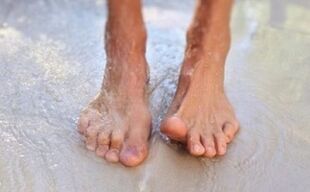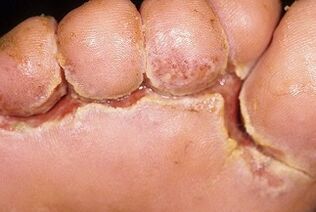About 80% of the population is affected by skin fungus. Due to increased density and sweating, mycoses are more affected by the skin of the feet. Fungal infection manifests itself with peeling and itching, but can be asymptomatic and causes only the appearance of seals (calluses, corns - hyperkeratosis in the heel and toe arches). If left untreated, the infection spreads. The patient can infect others and spread germs throughout the body.
Where did the fungus come from

Fungal microorganisms love a moist and warm environment and abundant nutrients. As a "shelter" they use dense skin, which tends to increase the secretion of fat and sweat.
Human feet - always a good breeding ground for mycobacteria, and poor quality socks and shoes help.
You can be infected in a public place - on the beach, sauna, pool. You can bring an infection when trying on new shoes, because a person with foot mycosis could have measured it the day before.
Some internal factors also increase susceptibility to fungi:
- Weakness of immunity - fungi reject the body's defenses, when weakened, it is easier for microorganisms to penetrate the skin;
- endocrine diseases - diabetes and hormonal imbalances change the composition of skin secretions, making them a breeding ground for bacteria;
- permanent injuries - cracks, abrasions, scratches and holes can be the passage of fungi;
- Lack of hygiene - poor quality foot washing, use of dirty socks and airtight shoes cause fungal infestation of the limbs.
Infection is also possible from a loved one - if there is a patient at home or a fungal carrier with an asymptomatic course of the disease. Disputes of pathogenic microorganisms spread to household appliances, personal belongings, sex (if the patient moves barefoot). When washing the belongings of all the inhabitants of the house, mycobacteria enter the clothes of healthy family members, and can cause mycosis not only on the legs, but also on other parts of the body (wrinkles, groin, hairy areas). of the body).
Why mushrooms appear between your fingers
Interdigital fungus is a special clinical form of foot mycosis. Doctors call it intertriginous. With this course, the skin is affected between 3 and 4 or 4 and 5 fingers. Often, the pathological process begins in one organ and eventually progresses to a healthy organ.

Mycosis begins with a crack in the skin between the toes or under the phalanx. The size of the wound can be from 2-3 mm to 1 cm. The intensity of the symptoms depends on the area of the wound - the larger the injury, the stronger the pain. As soon as the crack appears, the person feels a slight discomfort that increases with the hygiene procedures while walking.
Unlike other injuries, cracks do not heal on their own. Inflammation, produces exudate. The surface between the fingers is moisturized, which helps the fungus to spread to larger areas of skin. A "fringe" appears around the wound - steamed peeled skin. The support is very thick, and attempts to remove it with your fingers end up damaging healthy areas of the skin. Continuous peeling appears around the lesion. It can be lamellae or floury. The scales are silver, white, yellowish. These characteristics depend on the type of fungus that infects the skin. Once the cracks have healed, the intriginous form of the mycosis turns into squamous - manifesting itself as large dry areas of the foot with numerous scaly scales. The surface can be glossy or textured.
What to do with the symptoms of the fungus
If you have a crack between your fingers covered with loose skin, you should definitely consult a dermatologist. The specialist will examine and determine the symptoms not only at the site of injury, but also in other parts of the joint.
Diagnosis cannot be made on the basis of symptoms alone. A microscopic examination of the itchy foot will be required to confirm the fungus. In the case of resistant mycosis, it is supplemented by PCR analysis or culture inoculation to determine the type of pathogen and its susceptibility to antifungal drugs.
Systemic medications will be required in cases of advanced fungus or extensive damage to the dermis. Due to the possibility of hepato- and nephrotoxic effects of such drugs, the patient should undergo blood and urine tests. Based on their results, the specialist evaluates the work of vital organs, selects a treatment regimen with systemic antifungals.
Self-medication for fungal infections of the feet is allowed only in the early stages. You can cope with topical medications without systemic side effects.
Effective remedies against interdigital fungi
The specifics of therapy depend on the patient's individual data, the degree of mycosis, the area of the lesion, the presence of a secondary infection or resistance to the pathogen.
Systemic drugs
To speed up and complete treatment, doctors prescribe antifungal agents in tablet or capsule form.
It is undesirable to consume alcohol, fatty foods and other foods that burden the liver when treated with systemic drugs. If the infection spreads from the interdigital space to the nails, longer use of antifungals will be required.
Local remedies
Medications for the treatment of interdigital fungi are prescribed in moderately oily or non-oily (creams, solutions). Ointments can be used only in the initial stage, when the skin needs to be softened for rapid healing of lesions. Along the way, antifungal medications can be prescribed therapeutic and antiseptic substances. Accelerates the regeneration process & additionally softens rough skin
External substances with a wide range of fungicidal components are prescribed for the treatment of athlete's foot. Ideal for products:
- terbinafine;
- clotrimazole;
- ketoconazole;
- econazole;
- naftifina.
Price does not affect the success of treatment, it is important to choose the right active ingredient of the drug.
Creams and solutions are applied to the skin 1-2 times a day after hygiene procedures. After processing, the product is allowed to be completely absorbed and wear cotton socks. In parallel, the shoes should be disinfected every 3-7 days. Fungicidal sprays are used for this purpose. Socks, underwear, towels need to be changed regularly. Items used at high temperatures should be washed separately from other accessories for the patient and family members.
With trichophytosis and microsporia, doctors recommend special treatment regimens. For example, treat with iodine solution in the morning and sulfur, sulfur-tar or salicylic ointment in the evening.
Folk remedies
For a fungus can not be treated only by folk methods. In addition to the drug, baths are allowed. Medications should be used separately if your doctor recommends the use of home-made ointments or formulas. For example, use a ready-made medicine in the morning and evening, and in the afternoon - a homemade ointment. The most popular methods of treating a fungus among humans:
- oak bark baths- Prepare a large amount of broth from oak bark (6 tablespoons per 1 liter), dilute half with clean water, take a bath for 15 minutes every day;
- with sea salt- Prepare a strong solution of sea salt, take a bath for 10 minutes, do not wash off the salt, wear cotton socks immediately after the procedure;
- with soda- Dilute a tablespoon of soda in 1 liter of water, take a bath for 15 minutes, apply antifungal agents after wiping;
- egg ointment- 1 chicken egg mixed with a tablespoon of oil and vinegar, mix until smooth, apply under the bag for 3-4 hours, rinse with water;
- tea tree- Areas affected by the fungus are abundantly lubricated with tea tree essential oil, washed after 3 hours, sensitively diluted to half with neutral oils.
Rapid treatment of the fungus is facilitated by avoiding sweets, alcohol, fatty foods. The patient's diet should include plenty of vegetables, fermented dairy products, whole grains.
You should pay attention to foot hygiene to prevent the formation of fungus on the feet and between the toes. Avoid walking barefoot when visiting public places, use fungicides - any antifungal ointment or spray is applied after a shower. New shoes should only be measured with new socks; you should not give your slippers to anyone.
























